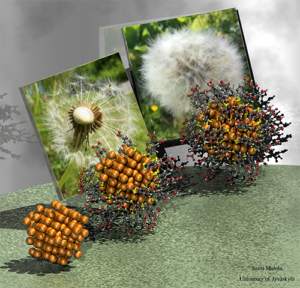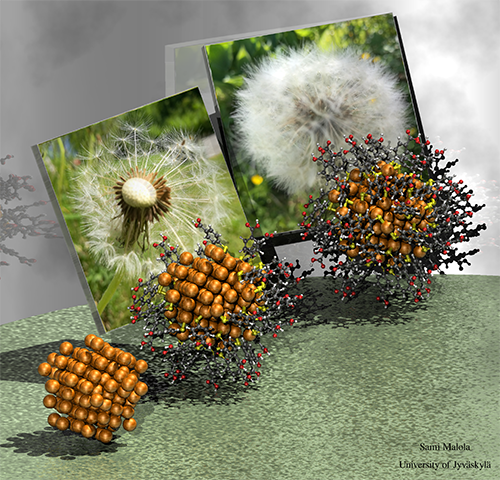
Predicting atomic structures of hybrid metal nanoparticles is, in principle, a similar problem to completing the floret shell of a “blown-out” dandelion. What are the optimal sites to add molecules (grey) on top of a metal core (in this case gold, orange spheres)? (Visualization: Sami Malola, University of Jyväskylä)
Researchers at the Nanoscience Center and Faculty of Information Technology in the University of Jyväskylä, Finland, have achieved a significant step forward in predicting atomic structures of hybrid nanoparticles. The work was carried out using supercomputing resources at CSC – IT Center for Science Ltd., Finland and at the Barcelona supercomputing center (BSC), Spain, as a part of a PRACE (Partnership for Advanced Computing in Europe) project.
This is a significant step forward within the context of new interdisciplinary collaboration in our university. Applying artificial intelligence to challenging topics in nanoscience, such as structural predictions for new nanomaterials, will surely lead to new breakthroughs,” said professor Tommi Kärkkäinen from the Faculty of Information Science in the University of Jyväskylä.
A research article published in Nature Communications on 3 September 2019, demonstrates a new algorithm that “learns”, with the help of artificial intelligence, to predict binding sites of molecules at the metal-molecule interface of hybrid nanoparticles by using already published experimental structural information on nanoparticle reference systems. The algorithm can in principle be applied to any nanometre-size structure consisting of metals and molecules provided that some structural information already exists on the corresponding systems.
The basic idea behind our algorithm is very simple. Chemical bonds between atoms are always discrete, having well-defined bond angles and bond distances. Therefore, every nanoparticle structure known from experiments, where the positions of all atoms are resolved accurately, tells something essential about the chemistry of the metal-molecule interface. The interesting question regarding applications of artificial intelligence for structural predictions is: how many of these already known structures we need to know so that predictions for new, yet unknown particles become reliable? It looks like we only need a few dozen of known structures, comments the lead author of the article, Sami Malola in Academy of Finland’s press release. Malola works as a University Researcher at the Nanoscience Center of the University of Jyväskylä.
Nanometre-sized hybrid metal nanoparticles have many applications in different processes, including catalysis, nanoelectronics, nanomedicine and biological imaging. The research was funded by the AIPSE research programme of the Academy of Finland (Novel Applications of Artificial Intelligence in Physical Sciences and Engineering Research).
In the next phase of this work we will build efficient atomic interaction models for hybrid metal nanoparticles by using machine learning methods. These models will allow us to investigate several interesting and important topics such as particle-particle reactions and the nanoparticles’ ability to function as delivery vehicles for small drug molecules, says Academy Professor Hannu Häkkinen, who led the study.
In addition to Malola, Häkkinen and Kärkkäinen, the article was co-authored by PhD Paavo Nieminen, PhD student Antti Pihlajamäki and postdoctoral researcher Joonas Hämäläinen.




